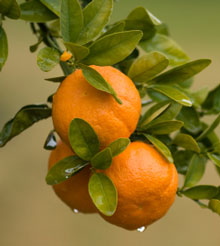Mandarin Orange: 'Satsuma'
Spring
prune to desired height; control in container
USDA Zone 4 to USDA Zone 11
Full sun
This variety is of ancient and unknown Japanese origin presumably from the old province of Owari, whence the name. Satsumas are Mandarin oranges, but technically are not Clementines. Owari Satsumas are one of the most cold tolerant orange trees you can grow.
PLEASE CALL OR EMAIL FOR CURRENT AVAILABILITY
| Size | Price |
|---|---|
| 5 gal | $65.00 |
| 10 gal | $85.00 |
| 7 gal | $75.00 |
| 3 gal | $55.00 |
Owari Satsuma is the most common of the many Satsuma mandarin selections grown in the United States, although other selections are being introduced. Because of its many fine qualities, Satsuma has been the focus of extensive efforts to extend its season of availability. Owari Satsuma trees are cold-hardy, productive, and vigorous-growing, but mature to a small size with a spreading and somewhat drooping habit. The fruit varies in shape depending upon the conditions where it is grown, but it is most commonly oblate with a smooth and thin orange rind that is easily peeled. The flesh is bright orange, tender and juicy, and mild in flavor. The Owari Satsuma is considered to be a mid-season fruit, with its season of harvest being December to January in most areas of California. The fruit itself does not hold well on the tree, but it stores well after harvest.
Colder and Northern areas can pot Satsumas in large containers and move them indoors or in the garage during extreme temperatures. They make a great looking winter houseplant, with their bright oranges against deep green leaves. Prune them to your desired size. If left untrimmed, they will eventually grow up to 10-12 feet tall.
Satsumas are drought tolerant and very easy to grow. Like most citrus trees, they like to dry out before being watered. So you can go on vacation and never worry about them.
